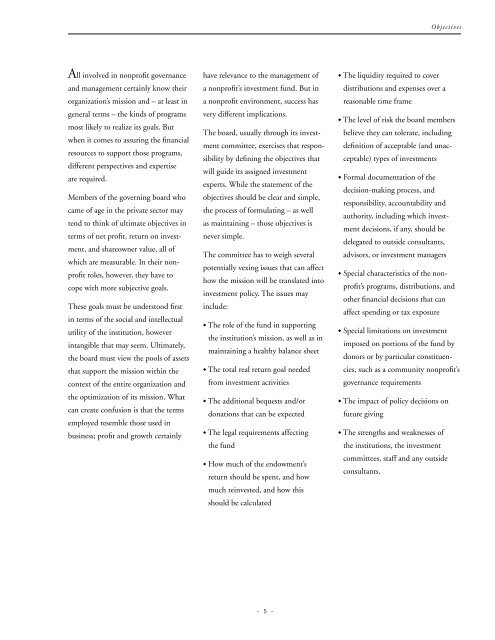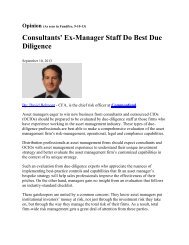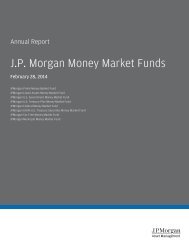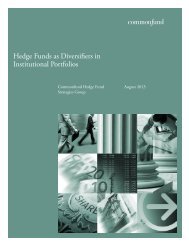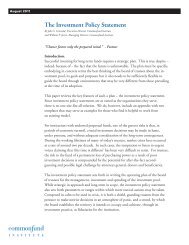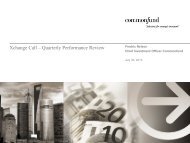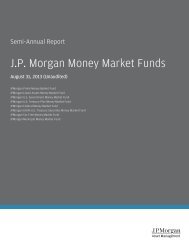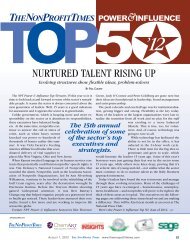Principles of Nonprofit Investment Management - Commonfund
Principles of Nonprofit Investment Management - Commonfund
Principles of Nonprofit Investment Management - Commonfund
You also want an ePaper? Increase the reach of your titles
YUMPU automatically turns print PDFs into web optimized ePapers that Google loves.
ObjectivesAll involved in nonpr<strong>of</strong>it governanceand management certainly know theirorganization’s mission and – at least ingeneral terms – the kinds <strong>of</strong> programsmost likely to realize its goals. Butwhen it comes to assuring the financialresources to support those programs,different perspectives and expertiseare required.Members <strong>of</strong> the governing board whocame <strong>of</strong> age in the private sector maytend to think <strong>of</strong> ultimate objectives interms <strong>of</strong> net pr<strong>of</strong>it, return on investment,and shareowner value, all <strong>of</strong>which are measurable. In their nonpr<strong>of</strong>itroles, however, they have tocope with more subjective goals.These goals must be understood firstin terms <strong>of</strong> the social and intellectualutility <strong>of</strong> the institution, howeverintangible that may seem. Ultimately,the board must view the pools <strong>of</strong> assetsthat support the mission within thecontext <strong>of</strong> the entire organization andthe optimization <strong>of</strong> its mission. Whatcan create confusion is that the termsemployed resemble those used inbusiness; pr<strong>of</strong>it and growth certainlyhave relevance to the management <strong>of</strong>a nonpr<strong>of</strong>it’s investment fund. But ina nonpr<strong>of</strong>it environment, success hasvery different implications.The board, usually through its investmentcommittee, exercises that responsibilityby defining the objectives thatwill guide its assigned investmentexperts. While the statement <strong>of</strong> theobjectives should be clear and simple,the process <strong>of</strong> formulating – as wellas maintaining – those objectives isnever simple.The committee has to weigh severalpotentially vexing issues that can affecthow the mission will be translated intoinvestment policy. The issues mayinclude:◆ The role <strong>of</strong> the fund in supportingthe institution’s mission, as well as inmaintaining a healthy balance sheet◆ The total real return goal neededfrom investment activities◆ The additional bequests and/ordonations that can be expected◆ The legal requirements affectingthe fund◆ How much <strong>of</strong> the endowment’sreturn should be spent, and howmuch reinvested, and how thisshould be calculated◆ The liquidity required to coverdistributions and expenses over areasonable time frame◆ The level <strong>of</strong> risk the board membersbelieve they can tolerate, includingdefinition <strong>of</strong> acceptable (and unacceptable)types <strong>of</strong> investments◆ Formal documentation <strong>of</strong> thedecision-making process, andresponsibility, accountability andauthority, including which investmentdecisions, if any, should bedelegated to outside consultants,advisors, or investment managers◆ Special characteristics <strong>of</strong> the nonpr<strong>of</strong>it’sprograms, distributions, andother financial decisions that canaffect spending or tax exposure◆ Special limitations on investmentimposed on portions <strong>of</strong> the fund bydonors or by particular constituencies,such as a community nonpr<strong>of</strong>it’sgovernance requirements◆ The impact <strong>of</strong> policy decisions onfuture giving◆ The strengths and weaknesses <strong>of</strong>the institutions, the investmentcommittees, staff and any outsideconsultants.- 5 -


